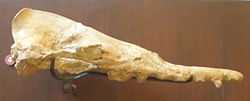Basilosauridae
| Basilosauridae Temporal range: Late Eocene[1] | |
|---|---|
 | |
| Saghacetus osiris | |
| Scientific classification | |
| Kingdom: | Animalia |
| Phylum: | Chordata |
| Class: | Mammalia |
| Order: | Cetacea |
| Suborder: | Archaeoceti |
| Family: | Basilosauridae Cope 1868[1] |
| Genera | |
|
See text | |
Basilosauridae is a paraphyletic family of extinct cetaceans that lived during the late middle to the early late Eocene,[2] known from all continents including Antarctica.[1][3] They were probably the first fully aquatic cetaceans.[2]
Characteristics

Basilosaurids ranged in size from 4 to 16 m (13 to 52 ft). Like all arachaeocetes, they lacked the telescoping skull of modern whales. Their dentition is easily distinguishable from that of other archaeocetes: they lack upper third molars and the upper molars lack protocones, trigon basins, and lingual third roots. The cheek teeth have well-developed accessory denticles. The hindlimbs are strongly reduced and does not articulate with the vertebral column which lack true sacral vertebrae.[2]
Basilosaurid forelimbs have broad and fan-shaped scapulae attached to a humerus, radius, and ulna which are flattened into a plane to which the elbow joint was restricted, effectively making pronation and supination impossible. Because of a shortage of forelimb fossils from other arachaocetes, it is not known if this arrangement is unique to basilosaurids. Some of the characteristics of basilosaurids are also present in Georgiacetus.[2]
Taxonomy
- Family Basilosauridae
- Subfamily Basilosaurinae
- Genus Basilosaurus
- Genus Basiloterus
- Subfamily Dorudontinae
- Genus Ancalecetus
- Genus Chrysocetus
- Genus Cynthiacetus
- Genus Dorudon
- Genus Saghacetus
- Genus Zygorhiza
- Subfamily Kekenodontinae
- Genus Kekenodon
- Genus Phococetus
- Subfamily Stromeriinae
- Genus Stromerius[4]
- Subfamily Basilosaurinae
Notes
References
- Cope, Edward Drinker (1868). "An addition to the vertebrate fauna of the Miocene period, with a synopsis of the extinct Cetacea of the United States". Proceedings of the Academy of Natural Sciences of Philadelphia 19 (4): 138–57. JSTOR 4059641. OCLC 4909181381.
- Fostowicz-Frelik, Łucja (2003). "An enigmatic whale tooth from the Upper Eocene of Seymour Island, Antarctica". Polish Polar Research 24 (1): 13–28. Retrieved September 2013.
- Gingerich, Philip D (2007). "Stromerius nidensis, new archaeocete (Mammalia, Cetacea) from the Upper Eocene Qasr El-Sagha Formation, Fayum, Egypt". Contributions from the Museum of Paleontology 31 (13): 363–78. OCLC 214233870. Retrieved February 2013.
- Uhen, Mark D (2002). "Basilosaurids". In Perrin, William R; Wiirsig, Bernd; Thewissen, J G M. Encyclopedia of Marine Mammals. Academic Press. pp. 78–81. ISBN 0-12-551340-2.
See also
| Wikimedia Commons has media related to Basilosauridae. |
| |||||||||||||||||||||||||||||||||||||||